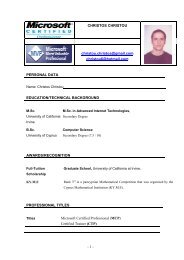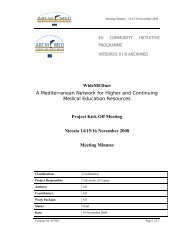Routing Protocols for Ad Hoc Mobile Wireless Networks
Routing Protocols for Ad Hoc Mobile Wireless Networks
Routing Protocols for Ad Hoc Mobile Wireless Networks
You also want an ePaper? Increase the reach of your titles
YUMPU automatically turns print PDFs into web optimized ePapers that Google loves.
<strong>Routing</strong> <strong>Protocols</strong> <strong>for</strong> <strong>Ad</strong> <strong>Hoc</strong> <strong>Mobile</strong> <strong>Wireless</strong> <strong>Networks</strong><br />
if symmetric links are supported. In case symmetric links are not supported, the node can initiate route<br />
discovery to source and piggyback the route reply on this new route request.<br />
DSRP uses two types of packets <strong>for</strong> route maintenance:- Route Error packet and Acknowledgements.<br />
When a node encounters a fatal transmission problem at its data link layer, it generates a Route Error<br />
packet. When a node receives a route error packet, it removes the hop in error from it's route cache. All<br />
routes that contain the hop in error are are truncated at that point. Acknowledgment packets are used to<br />
verify the correct operation of the route links. This also includes passive acknowledgments in which a<br />
node hears the next hop <strong>for</strong>warding the packet along the route.<br />
3.4 Temporally Ordered <strong>Routing</strong> Algorithm<br />
The Temporally Ordered <strong>Routing</strong> Algorithm (TORA) is a highly adaptive, efficient and scalable<br />
distributed routing algorithm based on the concept of link reversal [Park97]. TORA is proposed <strong>for</strong><br />
highly dynamic mobile, multihop wireless networks. It is a source-initiated on-demand routing protocol.<br />
It finds multiple routes from a source node to a destination node. The main feature of TORA is that the<br />
control messages are localized to a very small set of nodes near the occurrence of a topological change.<br />
To achieve this, the nodes maintain routing in<strong>for</strong>mation about adjacent nodes. The protocol has three<br />
basic functions: Route creation, Route maintenance, and Route erasure.<br />
Each node has a quintuple associated with it -<br />
● Logical time of a link failure<br />
● The unique ID of the node that defined the new reference level<br />
● A reflection indicator bit<br />
● A propagation ordering parameter<br />
● The unique ID of the node<br />
The first three elements collectively represent the reference level. A new reference level is defined each<br />
time a node loses its last downstream link due to a link failure. The last two values define a delta with<br />
respect to the reference level [Park97].<br />
Route Creation is done using QRY and UPD packets. The route creation algorithm starts with the height<br />
(propagation ordering parameter in the quintuple) of destination set to 0 and all other node's height set to<br />
NULL (i.e. undefined). The source broadcasts a QRY packet with the destination node's id in it. A node<br />
with a non-NULL height responds with a UPD packet that has its height in it. A node receiving a UPD<br />
packet sets its height to one more than that of the node that generated the UPD. A node with higher<br />
height is considered upstream and a node with lower height downstream. In this way a directed acyclic<br />
graph is constructed from source to the destination. Figure 6 illustrates a route creation process in TORA.<br />
As shown in figure 6a, node 5 does not propagate QRY from node 3 as it has already seen and<br />
propagated QRY message from node 2. In figure 6b, the source (i.e. node 1) may have received a UPD<br />
each from node 2 or node 3 but since node 4 gives it lesser height, it retains that height.<br />
http://www.cis.ohio-state.edu/~jain/cis788-99/adhoc_routing/index.html (13 of 20) [2/7/2000 10:38:34 AM]




